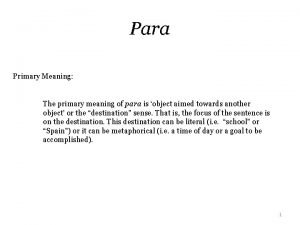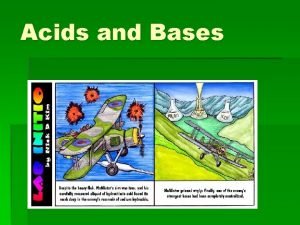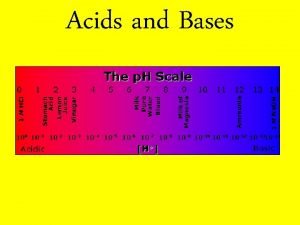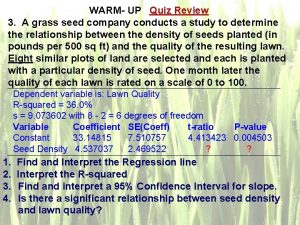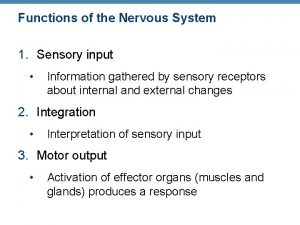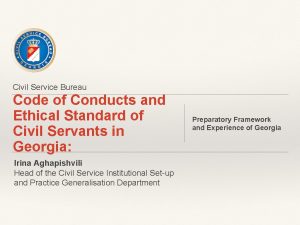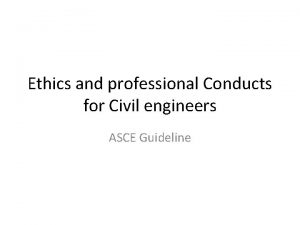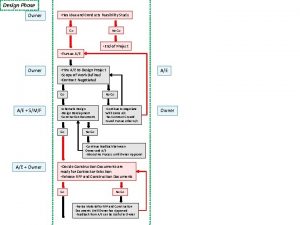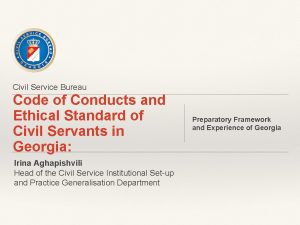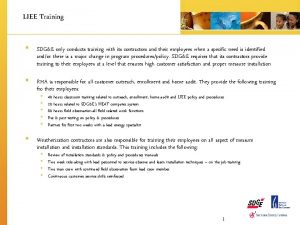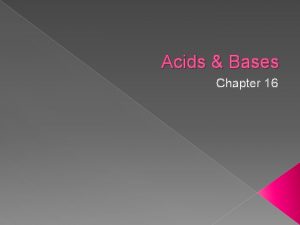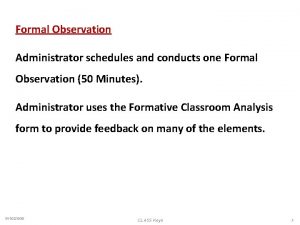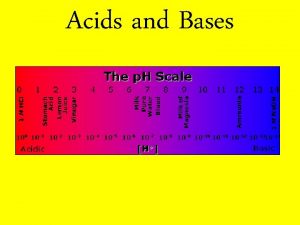Mission of CMAVE The Center conducts research aimed




















































- Slides: 52

Mission of CMAVE The Center conducts research aimed at reducing or eliminating the harm caused by insects to crops, stored products, livestock and humans. Research is directed not only at the insects themselves but at pathogens they may transmit and at identifying inherent protective mechanisms in plants.


Chemistry Research Unit. Mission – investigates the chemical, biochemical and physiological factors that regulate insect behavior and the interaction of insects with plants and other organisms in the environment. Research Approaches – research focus is on identification, synthesis, biochemistry and behavioral analysis of semiochemicals that affect and influence insect behavior and physiology

Keys to Success. No single approach will result in effective control of a pest population. Ask simple questions. Know the system you are working in – know the insect inside and out. Dwell on your strengths develop effective collaborations to overcome weaknesses.

Insect Chemistry Research Unit: major project areas: Endogenous regulation of sexual maturity and sexual communication in pest insects.

Improving Efficacy of SIT by incorporation of Hormone and Dietary Supplements into Adult Holding Protocols

Males Require Several Days to Begin to Release Sex Pheromone or to Mate.

Mated Males Remated Much More Rapidly than did Virgin Males of the Same Age

Mated Females Released 2 X More Pheromone

In the Tephritid Fruit Flies Both sexes require several days to become reproductively mature. This is similar to cockroaches and moths which have a period of reproductive diapause. In both moths and cockroaches Juvenile Hormone regulates reproductive development!

We Hypothesized that: Juvenile Hormone levels changed after mating. In young flies this resulted in improved sexual signaling and increased the probability that a male would mate. That Juvenile Hormone was the pivotal hormone regulating coordination of reproductive development with sexual signaling.

To Determine if Juvenile Hormone was involved we: Needed to identify JH from the blood of adult flies. Needed to show that JH levels were different in Mated and Virgin flies of the SAME age.

Two Juvenile Hormones have been Proposed to Function in Diptera Juvenile Hormone III is well documented to act in all insects.


We Identified Both JH III and JH III Bisepoxide from Hemolymph

Hemolymph from Mated Males Contained Significantly More JH than That from Virgins

We Applied Juvenoids Topically

Application of JH on Day 5 Induced Greater Pheromone Production on Day 6!

Application of Juvenile Hormone to Sterile Males Induced All Males to Mate Much Earlier.

Potential Use of Knowledge of Endocrine Regulation of Reproduction for Pest Control Improvement of Efficacy of SIT Programs. Incorporation of Analogs into Mass Rearing Programs or Release Protocols to Induce Sterile Males To undergo Accelerated Reproductive Maturity.

Improving Efficacy of SIT For Tephritids that require 7 -12 days (Mexican, West Indian, Caribbean) to become sexually mature adding hormone to adult holding protocols is effective.

Hormone Therapy Will it be effective for Med Flies? The reason I ask is that Med Flies are not supposed to need 710 days to become sexually mature!

Hormone Therapy to Improve Efficacy of SIT for the Medfly!. Studies using the single sex strain of males from Guatemala. Females from the mixed sex strain in Guatemala. We thank the folks in Guatemala for support!

Effect of Topical Application of Hormone to Pupae 24 h before Eclosion

Effect of Topical Application of Methoprene to Eclosed Adult Males on Calling

Two Day Old Male Medflies Released More Than Twice the Pheromone as Control Males Released

Treated Medflies Released Pheromone Earlier than Control Flies!

Feeding Methoprene to Flies Can we feed a water soluble formulation to adult flies and induce accelerated reproductive development?

Feeding Methoprene to Flies Methoprene used is a water soluble commercial formulation - “Nevweb igr 200” We are now testing a commercial formulation from Wellmark International and thank them for providing the formulation! Currently we incorporate 0. 05% methoprene in diet.

Feeding Hormone to Males in the 3: 1 Sugar: Protein Dry Diet Induced Males to Call Much Earlier.

Development of Delivery Technology with Caribbean Flies We began to assess delivery of hormone by incorporation of Methoprene, the JH mimic having the best overall activity, into AGAR-SUGAR food blocks. However, we encountered a significant problem with the AGAR-SUGAR diet in tests using the Caribbean Fruit Fly!

Flies Fed the AGAR Diet Were Much Less Attractive that Flies Fed the Dry Diet!

Diet Studies Clearly diet has an effect on Sexual Signaling by Male Caribbean Fruit Flies. Dry Diet Studies: Optimal Diet (3: 1 Sugar to Protein Hydrolysate). What is important?

Dry Diet Study: Does Feeding Protein Increase Pheromone Release?

Dry Diet Study: Does Feeding Protein Improve Attraction?

Percent of Capture in Traps Emitting Pheromone from males fed Different Percents of Protein in Agar/Sugar blocks

Hormone Therapy to Improve Efficacy of SIT for Tephritid Fruit Flies (Now the Medfly!).

Med Flies Fed Agar Sugar Diet (Control Diet)

Addition of 10% Protein to Agar Sugar Diet

Effect of adding Hormone to Sugar Agar and Protein Diet A

Effect of Hormone + Protein in Sugar Agar Diet on Female Capture

The Overall Benefits are Greater than the Sum of Each Improvement!

Insect Chemistry Research Unit: major project areas: Tritrophic interactions among insect herbivors, plants and insect predators/parasites.

Harnessing Plant Defenses Plants are capable of defending against insect herbivores and pathogens Direct and indirect defense can be formidable Understanding plant defensive mechanisms will lead to: More sustainable effective management of insect pests and pathogens



100 90 90 Oviposition (%) 100 Time (%) 80 70 60 50 40 30 30 20 20 10 10 0 0 Undamage d plants Damaged + Undamaged plants

White Mold on Peanut Plant

Leaf Area Consumed (%) Feeding by Spodoptera exigua larvae on leaves from healthy and white moldinfected peanuts

Insect Chemistry Research Unit: major project areas: Identification of new attractants for insect pests (Small Hive Beetle, Parasitoids, Tephritid Fruit Flies).

Isolation and Identification of the Pheromone of the Fruit Fly Parasitoid Diachasmimorpha longicaudata Female choice in yellow Multilure traps tested in a flight tunnel (n =3 )synthetic lures vs live males

The Pheromone of Diachasmimorpha longicaudata may be important for monitoring but it is not really potent. Is there something better? Females are attracted to sweet Allysum a common garden plant. However, this plant does not occur naturally in the host range of the wasp! WHAT IS GOING ON?
 Max scheler empathy theory advantages and disadvantages
Max scheler empathy theory advantages and disadvantages Naturalistic observation def
Naturalistic observation def Difference between primary and secondary group ppt
Difference between primary and secondary group ppt Primarymeaning
Primarymeaning Systematic inquiry aimed at the discovery of new knowledge
Systematic inquiry aimed at the discovery of new knowledge What conducts power and ground to the driver's side airbag?
What conducts power and ground to the driver's side airbag? What conducts power and ground to the driver's side airbag?
What conducts power and ground to the driver's side airbag? Water conducts electricity
Water conducts electricity Substance whose water solution conducts a current
Substance whose water solution conducts a current Conducts electricity acid or base
Conducts electricity acid or base The cpmt conducts the bia in three stages
The cpmt conducts the bia in three stages Which officer presides over and conducts meetings in fbla
Which officer presides over and conducts meetings in fbla A grass seed company conducts a study
A grass seed company conducts a study A substance whose water solution conducts a current is a(n)
A substance whose water solution conducts a current is a(n) Conducts local currents toward the soma
Conducts local currents toward the soma Hát kết hợp bộ gõ cơ thể
Hát kết hợp bộ gõ cơ thể Ng-html
Ng-html Bổ thể
Bổ thể Tỉ lệ cơ thể trẻ em
Tỉ lệ cơ thể trẻ em Gấu đi như thế nào
Gấu đi như thế nào Chụp tư thế worms-breton
Chụp tư thế worms-breton Hát lên người ơi
Hát lên người ơi Môn thể thao bắt đầu bằng chữ f
Môn thể thao bắt đầu bằng chữ f Thế nào là hệ số cao nhất
Thế nào là hệ số cao nhất Các châu lục và đại dương trên thế giới
Các châu lục và đại dương trên thế giới Cong thức tính động năng
Cong thức tính động năng Trời xanh đây là của chúng ta thể thơ
Trời xanh đây là của chúng ta thể thơ Cách giải mật thư tọa độ
Cách giải mật thư tọa độ Phép trừ bù
Phép trừ bù Phản ứng thế ankan
Phản ứng thế ankan Các châu lục và đại dương trên thế giới
Các châu lục và đại dương trên thế giới Thơ thất ngôn tứ tuyệt đường luật
Thơ thất ngôn tứ tuyệt đường luật Quá trình desamine hóa có thể tạo ra
Quá trình desamine hóa có thể tạo ra Một số thể thơ truyền thống
Một số thể thơ truyền thống Cái miệng xinh xinh thế chỉ nói điều hay thôi
Cái miệng xinh xinh thế chỉ nói điều hay thôi Vẽ hình chiếu vuông góc của vật thể sau
Vẽ hình chiếu vuông góc của vật thể sau Biện pháp chống mỏi cơ
Biện pháp chống mỏi cơ đặc điểm cơ thể của người tối cổ
đặc điểm cơ thể của người tối cổ V cc
V cc Vẽ hình chiếu đứng bằng cạnh của vật thể
Vẽ hình chiếu đứng bằng cạnh của vật thể Tia chieu sa te
Tia chieu sa te Thẻ vin
Thẻ vin đại từ thay thế
đại từ thay thế điện thế nghỉ
điện thế nghỉ Tư thế ngồi viết
Tư thế ngồi viết Diễn thế sinh thái là
Diễn thế sinh thái là Dot
Dot Các số nguyên tố
Các số nguyên tố Tư thế ngồi viết
Tư thế ngồi viết Lời thề hippocrates
Lời thề hippocrates Thiếu nhi thế giới liên hoan
Thiếu nhi thế giới liên hoan ưu thế lai là gì
ưu thế lai là gì Khi nào hổ con có thể sống độc lập
Khi nào hổ con có thể sống độc lập



